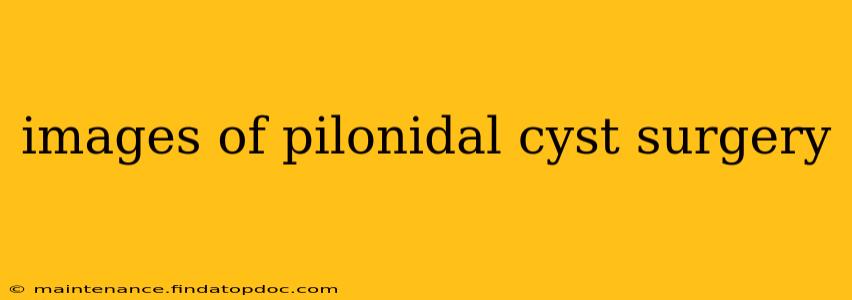Images of Pilonidal Cyst Surgery: A Guide for Patients
Searching for "images of pilonidal cyst surgery" online can be overwhelming and potentially disturbing. While visual aids can be helpful for understanding the procedure, it's crucial to approach this topic with caution. Graphic images might not be suitable for all viewers and could cause anxiety. This article aims to provide information about pilonidal cyst surgery without resorting to explicit imagery, focusing instead on the process and recovery. Remember, always consult with your surgeon for personalized advice and to address any specific concerns you may have.
What is a Pilonidal Cyst?
A pilonidal cyst is a cyst or abscess that typically forms in the cleft of the buttocks. It's often filled with pus, hair, and skin debris. While the exact cause isn't fully understood, factors like excessive sweating, friction from clothing, and ingrown hairs are considered contributing factors. Symptoms can range from mild discomfort to significant pain, swelling, and drainage.
Types of Pilonidal Cyst Surgery:
Several surgical techniques exist for treating pilonidal cysts, and the best approach depends on the severity of the cyst and individual patient factors. Your surgeon will determine the most appropriate method for your specific situation. Common procedures include:
-
Open Wound Treatment: This involves removing the cyst and leaving the wound open to heal from the inside out. This method often requires more frequent dressing changes and takes longer to heal, but it reduces the risk of recurrence.
-
Closed Wound Treatment: In this procedure, the cyst is removed, and the wound is closed with stitches. It heals faster, but there's a higher chance of recurrence.
-
Limited Incision: This less invasive approach may be suitable for smaller, less complex cysts.
-
Laser Surgery: This technique uses a laser to remove the cyst and cauterize the surrounding tissue. It may offer faster healing and reduced scarring compared to traditional methods.
What to Expect During Surgery:
The procedure is typically performed under local or general anesthesia, depending on the extent of the surgery. Your surgeon will make an incision to remove the cyst and any infected tissue. The exact process will vary based on the chosen surgical technique.
H2: What are the risks associated with pilonidal cyst surgery?
As with any surgical procedure, pilonidal cyst surgery carries potential risks, including infection, bleeding, nerve damage, and scarring. Your surgeon will discuss these risks in detail during your consultation. The risk of recurrence is also a concern, and lifestyle modifications may be recommended post-surgery to minimize this possibility.
H2: How long is the recovery time for pilonidal cyst surgery?
Recovery time varies depending on the surgical technique used and individual healing rates. Open wound treatment typically takes longer to heal, often requiring several weeks or even months. Closed wound procedures generally have a shorter recovery period. Your surgeon will provide specific post-operative instructions, including wound care, pain management, and activity restrictions.
H2: What can I do to prevent a pilonidal cyst from recurring?
Preventing recurrence involves maintaining good hygiene, keeping the area clean and dry, and regularly trimming or removing hair from the affected area. Maintaining a healthy weight and wearing loose-fitting clothing can also help reduce friction and sweating.
H2: Will I need to take pain medication after pilonidal cyst surgery?
Pain medication is often prescribed following the surgery to manage any discomfort. The type and duration of medication will depend on your individual needs and pain tolerance.
H2: How much does pilonidal cyst surgery cost?
The cost of pilonidal cyst surgery varies depending on several factors, including the surgeon's fees, anesthesia costs, and the facility where the procedure is performed. It's important to discuss the cost with your surgeon's office before scheduling the procedure.
Important Note: This information is for educational purposes only and should not be considered medical advice. Always consult with a qualified healthcare professional for diagnosis and treatment of any medical condition. They can answer your questions about the procedure and provide personalized guidance. While avoiding explicit images, this article aims to inform you about the surgical process for pilonidal cysts, aiding your understanding and preparation.
